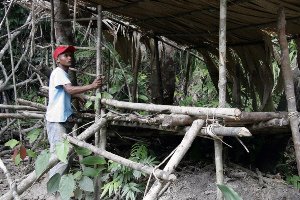February 18, 2006 19:43 PM
Society Claims To Have Scientific Evidence Of Bigfoot Colony
By Mohd Haikal Isa
Orang Asli youth, Herman Deraman, 21, showing the actual location where his hut was shaken by “Orang Lenggor” or Bigfoot near Sungai Madek Forest Reserved, Miles 25, Mersing-Kluang Road in December last year. Pix: Zid Omar
JOHOR BAHARU, Feb 18 (Bernama) -- The Johor Wildlife Protection Society said it has "scientific evidence" to prove the existence of Bigfoot whose reported sightings recently in the Johor jungles have excited the world's media.
Not just one Bigfoot but a whole colony of the giant, hairy creatures which the society named "Orang Lenggor" (Lenggor People) as one was spotted in an area by that name, said the society's secretary Tay Teng Hwa.
"We will make public the evidence soon," he said today.
He said a member of the society had studied the creatures for six years and interacted directly with the colony.
"The adult creatures are between 10 and 12 feet tall while their children are 6 to 7 footers. Seventy per cent of the Orang Lenggor have a human appearance but the rest resemble apes," he said.
Tay declined to reveal the location of the Bigfoot colony or the type of "scientific evidence" in the possession of the society.
The claim by the society followed a statement by Johor Menteri Besar Datuk Abdul Ghani Othman that he was convinced about the existence of Bigfoot based on information provided by Orang Asli.
Tay said the society decided to reveal its discovery because foreigners armed with sophisticated equipment were entering the Johor jungles to track down Bigfoot without the knowledge of the state government.
"We are worried these foreigners might find Bigfoot and then announce to the world as their discovery," he said.
Relating the background to the society's study of the creatures, he said a member of the society, who was a logger, came across Bigfoot when the creature encroached into the logging company's base camp to look for food.
Since that incident, the member began to study the creatures and went close to their colony.
Tay said the creatures, despite their size and rough appearance, were timid and showed no aggression to humans who approached them.
The "Orang Lenggor" had a covering of black hair on their bodies when they were young but the hair gradually turned brown as they grew older, he said.
"They like to eat fish and fruits they gather in the jungles, including durian. They also have a liking for river water that contains dissolved salt and would walk for miles to get it," he added.
Tay said the society would organise an expedition to the "Orang Lenggor" colony in either March or April.
-- BERNAMA
